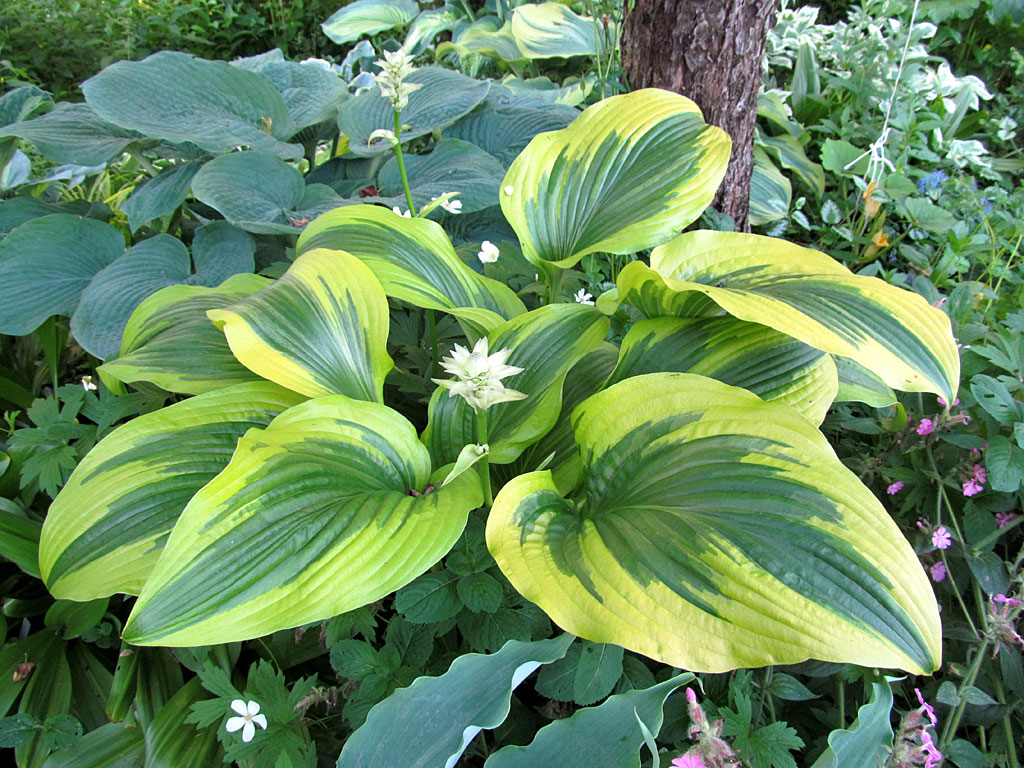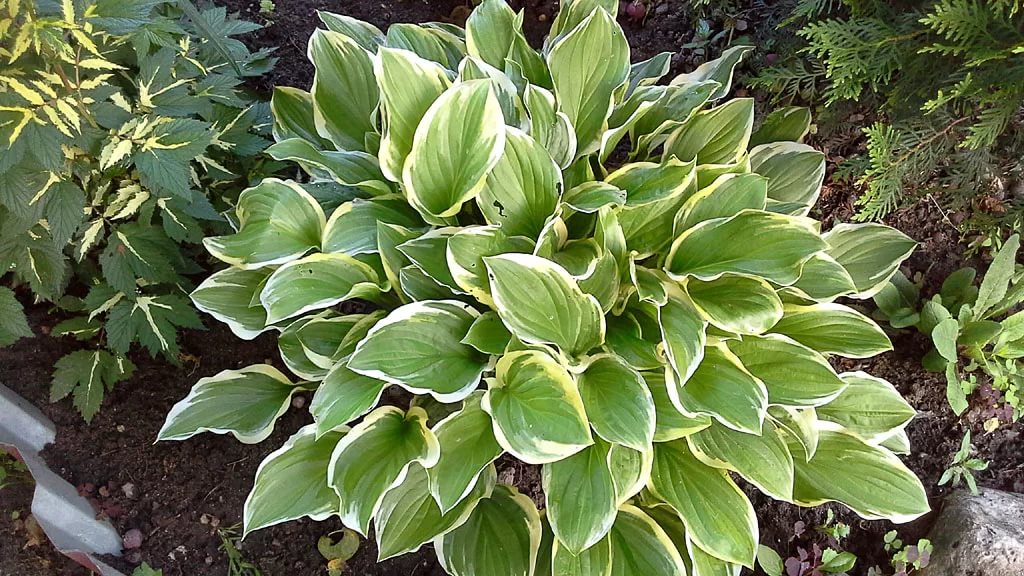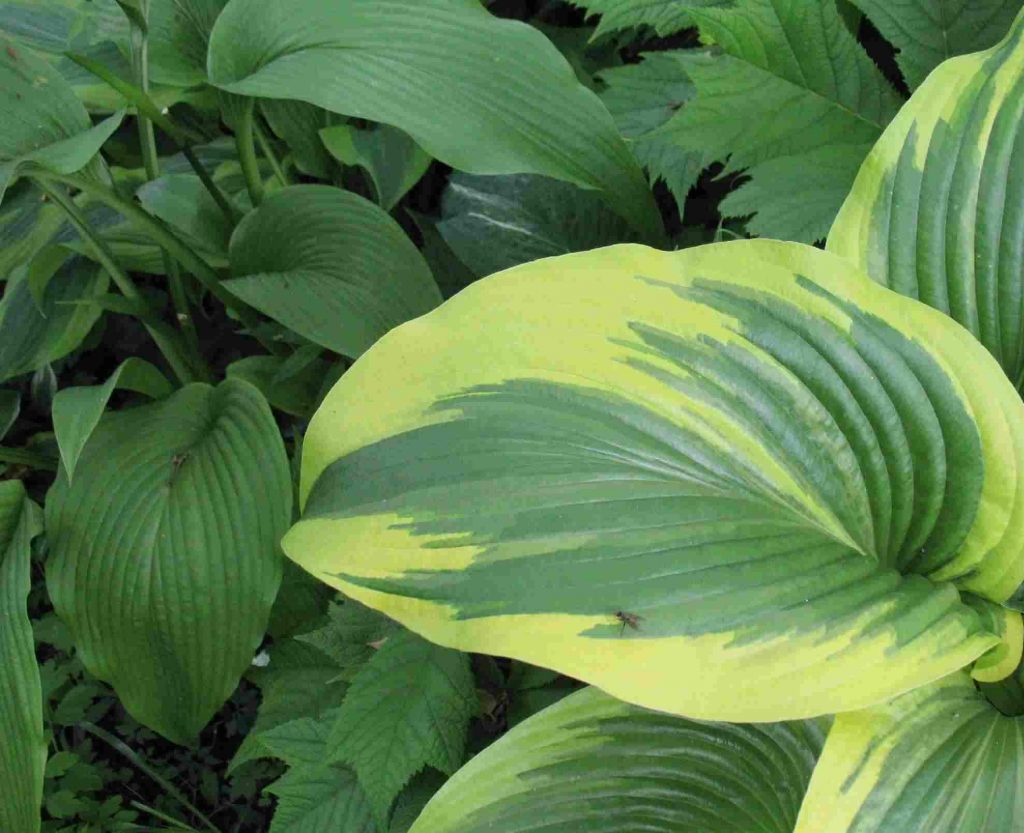Hosta Aureomarginata - garden decoration
Hosta Aureomarginata is an ornamental perennial from the Asparagus family. The name translates as "golden-bordered", which illustrates the original variegation of the leaves. There are two varieties with this name, one of which is the natural sport of the Fortune function, the other is the hosta Montana variety.

Host aureomarginata
Description of the variety
Fortunei Aureomarginata is a medium-sized variety that grows up to 50 cm, 120 cm in diameter. It has large leaves (30x20), heart-shaped. The center of the leaf plate is green, the feathery border is golden. It blooms in July with light lilac bells on high peduncles. Dome-shaped bush.
Montana Aureomarginata is a large function reaching 70 cm in height and 130 cm in width. The bush is fountain-shaped. Leaves are elongated (35x25 cm), venation, medium density. The central part is dark green, the border is yellow. Flowers - lavender, odorless.
Landing features
Aureomarginate can grow in the shade and sun, but light shade is the best option. Sunlight is useful in the morning and evening for the host (to make the border on the leaves brighter), and at noon, shading is desirable (to avoid burns).
The plant prefers fertile, moderately moist soils with a neutral or slightly acidic reaction. If groundwater is close or moisture accumulates (from precipitation), an embankment should be built at the landing site and a thick drainage layer should be laid.
The distance from the funkia to neighboring perennials is at least 50 cm.
Technology:
- Before planting, the soil is dug up and loosened.
- Dig a hole 70 cm deep and wide.
- Drainage is laid from pebbles, rubble or broken brick.
- The earth is mixed with peat and compost, a third is filled in the hole, and a bucket of water is poured over.
- A container seedling is transferred along with an earthen lump (for an open root system, the soil mixture is poured with a mound and the roots are straightened down the slopes).
- The remaining substrate is poured, compacted and watered again.
- From above, the soil is mulched with peat chips, sawdust, pine needles or pieces of bark.
Care
Hosta Aureomarginata needs soil moisture, annual pruning and several additional fertilizing per season.
These treatments promote good growth, disease prevention and excellent decorative effect.
In general, caring for is not difficult and is quite affordable for novice gardeners.
Watering
The moisture-loving function needs regular watering (2-3 times a week). However, the water should not stagnate under the bushes, provoking rot and fungal diseases.

Host fortunei aureomarginata
You need to water the plant at the root so that moisture does not get on the foliage.
Top dressing
The plant is fed in spring and autumn. Organic mulch made from compost and peat is used as fertilizer. Additionally, you can add a complex mineral dressing on the eve of flowering.
Pruning and preparing for winter
Dried peduncles are cut off at the end of flowering, and yellowed leaves - in autumn or early spring after wintering. This is a frost-resistant plant, but for the winter it is better to cover the bushes with fallen dry leaves.
Young seedlings are mulched with a thick layer of organic matter and covered with spruce branches.
Reproduction
The most popular way to propagate funkia is by cuttings. Also, good results are obtained by dividing the bush, but it is recommended to carry it out no more than once every 5-6 years.
Sowing seeds is almost never practiced because it does not guarantee the preservation of varietal characteristics.
Cuttings
The leaf rosette is cut with a petiole and a "heel", treated with a root stimulator. The earth is dug up in partial shade, loosened, moistened.

Aureomarginate host photo
The cuttings are deepened into the soil and covered with plastic bottles. Care consists in regular watering of seedlings and airing the "greenhouses". Roots appear within a month.
Dividing the bush
The bush is carefully dug up and divided into several parts. Each division must have at least one kidney. Then they are planted in the usual way in a shady place, watered and mulched.
To reduce the evaporation area, 2-3 leaves can be removed from the plant.
Diseases and pests
| Problem | Symptoms | Prophylaxis | Wrestling |
| Slugs, snails, caterpillars | Traces of mucus, eaten holes in the leaves. | The correct watering regime: moderately, at the root, in the morning, not in the evening; Sprinkle the soil with tobacco, soda, ash and pebbles. | Use beer traps, as well as pieces of plywood, boards; collect pests by hand. Apply products based on methyl aldehyde (Slime Eater). |
| Fungal diseases that provoke rot | The leaves turn brown, rot at the tips. The bush withers, stops growing, lays down. | Avoid waterlogging, lay good drainage, disinfect equipment. | Cut off the affected parts of the plant, treat Aureomarginate with fungicides. Transplant to a new location with healthy soil. In advanced cases, when the function cannot be treated, it must be burned, and not thrown into compost. |
Application in landscape design
The larger Aureomarginata Montana is more often grown as a tapeworm, and Fortune - as a groundcover and in group plantings. Both varieties are suitable for creating living borders, flower beds and garden paths. The function looks great in rocky gardens, rock gardens, mixborders, near water bodies.

Hosta montana aureomarginate
Aureomarginata goes well with thuja, junipers, dwarf spruce and pine varieties. In flower beds it is planted with roses, lilies, phlox, irises, delphinium. The host is suitable for container growing, which allows you to decorate terraces, gazebos, verandas, small courtyards without planting land.
Testimonials
According to the descriptions, Aureomarginata Fortune is grown more often than Montana, but both varieties receive positive reviews. The function of these varieties is resistant to frost and diseases, unpretentious to the soil, rarely subject to sunburn. She gratefully reacts to feeding, growing large and dense leaves with a bright border.
Many growers value the plant more for the correct shape of the bush and the beautiful variegation of the leaves than for the flowers. In order not to spoil the decorativeness of group plantings, they break off the peduncles without waiting for flowering. However, if the hosta is grown as a tapeworm, the lilac bells are left: they add funkii to the funkii and add color.

